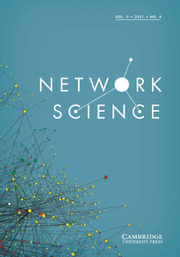Article contents
Algorithms for generating large-scale clustered random graphs
Published online by Cambridge University Press: 21 November 2014
Abstract
Real-world networks are often compared to random graphs to assess whether their topological structure could be a result of random processes. However, a simple random graph in large scale often lacks social structure beyond the dyadic level. As a result we need to generate clustered random graph to compare the local structure at higher network levels. In this paper a generalized version of Gleeson's algorithm G(VS, VT, ES, ET, S, T) is advanced to generate a clustered random graph in large-scale which persists the number of vertices |V|, the number of edges |E|, and the global clustering coefficient CΔ as in the real network and it works successfully for nine large-scale networks. Our new algorithm also has advantages in randomness evaluation and computation efficiency when compared with the existing algorithms.
Information
- Type
- Research Article
- Information
- Copyright
- Copyright © Cambridge University Press 2014
References
- 9
- Cited by

